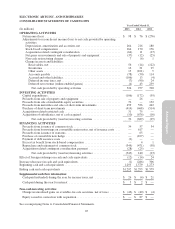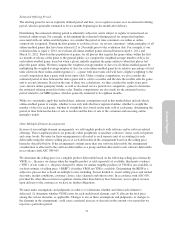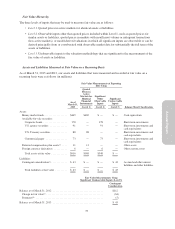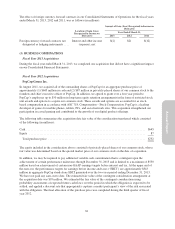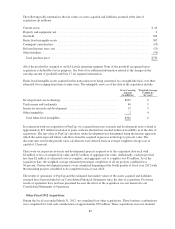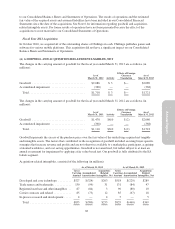Electronic Arts 2013 Annual Report Download - page 158
Download and view the complete annual report
Please find page 158 of the 2013 Electronic Arts annual report below. You can navigate through the pages in the report by either clicking on the pages listed below, or by using the keyword search tool below to find specific information within the annual report.The determination of the fair value of market-based restricted stock units, stock options and ESPP is affected by
assumptions regarding subjective and complex variables. Generally, our assumptions are based on historical
information and judgment is required to determine if historical trends may be indicators of future outcomes.
Employee stock-based compensation expense is calculated based on awards ultimately expected to vest and is
reduced for estimated forfeitures. Forfeitures are revised, if necessary, in subsequent periods if actual forfeitures
differ from those estimates and an adjustment to stock-based compensation expense will be recognized at that
time.
Foreign Currency Translation
For each of our foreign operating subsidiaries, the functional currency is generally its local currency. Assets and
liabilities of foreign operations are translated into U.S. dollars using month-end exchange rates, and revenue and
expenses are translated into U.S. dollars using average exchange rates. The effects of foreign currency translation
adjustments are included as a component of accumulated other comprehensive income in stockholders’ equity.
Foreign currency transaction gains and losses are a result of the effect of exchange rate changes on transactions
denominated in currencies other than the functional currency. Net foreign currency transaction gains (losses) of
$2 million, $(29) million, and $12 million for the fiscal years ended March 31, 2013, 2012 and 2011,
respectively, are included in interest and other income (expense), net, in our Consolidated Statements of
Operations.
Impact of Recently Issued Accounting Standards
In December 2011, the FASB issued ASU 2011-11, Disclosures about Offsetting Assets and Liabilities, which
creates new disclosure requirements about the nature of an entity’s rights of offset and related arrangements
associated with its financial instruments and derivative instruments. In January 2013, the FASB issued
ASU 2013-01, Clarifying the Scope of Disclosures about Offsetting Assets and Liabilities, to address concerns
expressed by preparers while still providing useful information about certain transactions involving master
netting arrangements. The new disclosures are designed to make financial statements that are prepared under
U.S. GAAP more comparable to those prepared under International Financial Reporting Standards. The
disclosure requirements are effective for annual reporting periods beginning on or after January 1, 2013, and
interim periods therein, with retrospective application required. We do not expect the adoption of ASU 2011-11
and ASU 2013-01 to have a material impact on our Consolidated Financial Statements.
In February 2013, the FASB issued ASU 2013-02, Comprehensive Income (Topic 220): Reporting of Amounts
Reclassified Out of Accumulated Other Comprehensive Income, effective prospectively for fiscal years beginning
after December 15, 2012. The amendments of this ASU require an entity to provide information about the
amounts reclassified out of accumulated other comprehensive income (“AOCI”) by component. In addition, an
entity is required to present, either on the face of the statement where net income (loss) is presented or in the
notes, significant amounts reclassified out of AOCI by the respective line items of net income but only if the
amount reclassified is required under U.S. GAAP to be reclassified to net income in its entirety in the same
reporting period. For other amounts that are not required under U.S. GAAP to be reclassified in their entirety to
net income, an entity is required to cross-reference to other disclosures required under U.S. GAAP that provide
additional detail about those amounts. We do not expect the adoption of ASU 2013-02 to have a material impact
on our Consolidated Financial Statements.
(2) FAIR VALUE MEASUREMENTS
There are various valuation techniques used to estimate fair value, the primary one being the price that would be
received from selling an asset or paid to transfer a liability in an orderly transaction between market participants
at the measurement date. When determining fair value, we consider the principal or most advantageous market in
which we would transact and consider assumptions that market participants would use when pricing the asset or
liability. We measure certain financial and nonfinancial assets and liabilities at fair value on a recurring and
nonrecurring basis.
74



